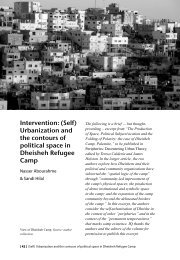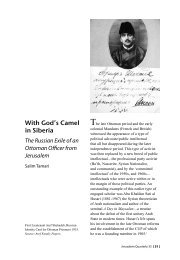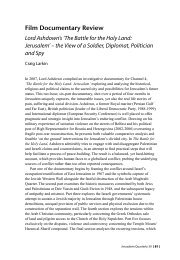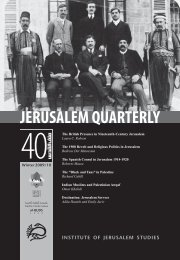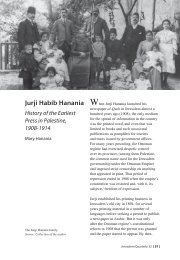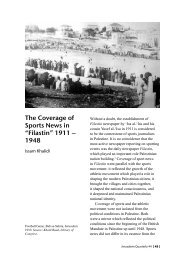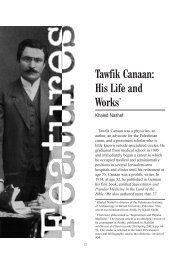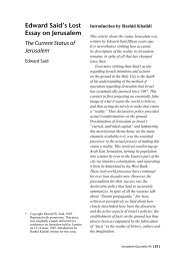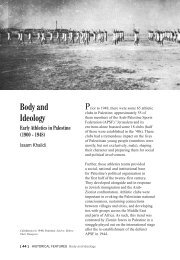PLUNDERING PALESTINE - Jerusalem Quarterly
PLUNDERING PALESTINE - Jerusalem Quarterly
PLUNDERING PALESTINE - Jerusalem Quarterly
Create successful ePaper yourself
Turn your PDF publications into a flip-book with our unique Google optimized e-Paper software.
Kletter does one thing that is virtually incomprehensible, even in the light of his<br />
clearly revealed partialities. He ‘outs’ a Palestinian victim of the Nakba, a former<br />
employee of the Mandatory Department of Antiquities, one who would be deemed a<br />
collaborator in later periods, showing him as he pleads unsuccessfully for three years<br />
from exile in Libya to be allowed to return, expressing joy at the name ‘Palestine’<br />
having been replaced by Israel, denouncing (by name) those who had resisted the<br />
Zionists, and who might possibly still have been in the country. The choice of<br />
documents here is baffling; the effect, chilling.<br />
The other remarkable aspect of this work is that it behaves as though Edward Said<br />
had never been, and Orientalist versions of history were not reserved to fanatics in the<br />
Bernard Lewis mould. We learn that Ottoman Palestine and by extension, the Ottoman<br />
Empire, was a place replete with “dark spots: ethnic groups were segregated; the bulk<br />
of archaeological research was carried out by foreigners; the Law of Antiquities was<br />
accomplished at the price of creating legal trade in antiquities... and each separate<br />
group was interested in ‘our past’…” (p. 295). The most casual amateur can spot<br />
the enormities in this paragraph (with the likes of which the book is peppered),<br />
from the choice of vocabulary (“dark spots”) to the counter-verities regarding ethnic<br />
segregation, the hegemony of foreigners, the money-grubbing Turks, the ubiquity of<br />
Zionist-type solipsism.<br />
A number of subjects are broached that might, if given some depth, have added<br />
to one’s understanding of specific issues. We find out how today’s Israel Museum<br />
in <strong>Jerusalem</strong> was originally financed (by US funds). But the story of the funds’<br />
disbursement is treated as a local scandal instead of being used, as it might, to<br />
bolster the literature on the history and teleology of museums in general (“follow<br />
the money!”). For this reason, it would not be correct to say that this book has no<br />
place – it does, in those libraries that can afford it. And it can there be regarded and<br />
employed as a primary source, since it quotes a large if select number of documents<br />
of various types, pertinent to the study of the history of the land, its native inhabitants,<br />
and those who moved in to take their place. Because of the period it chooses to cover,<br />
it avoids the pitfalls of having to qualify Israeli archaeology as a tool of the regionally<br />
expanding state in the way Meron Benvenisti, 2 Denys Pringle 3 and most of all, Nadia<br />
Abu El-Haj have done. Kletter’s treatment of his much-respected archaeological caste<br />
becomes more problematic as the years go by, since it is hard to blame others for<br />
the depredation, as he does for this early period (he accuses the Israeli military and,<br />
believe it or not, the Palestinian victims of the Nakba). How would he qualify their<br />
unequivocal involvement in settlement activities in these new territories, minus the<br />
fig-leaf of a recent European extermination campaign and hostile Arab armies and<br />
populations?<br />
[ 74 ] FEATURES Reparation for Lost Palestinian Property inside Israel


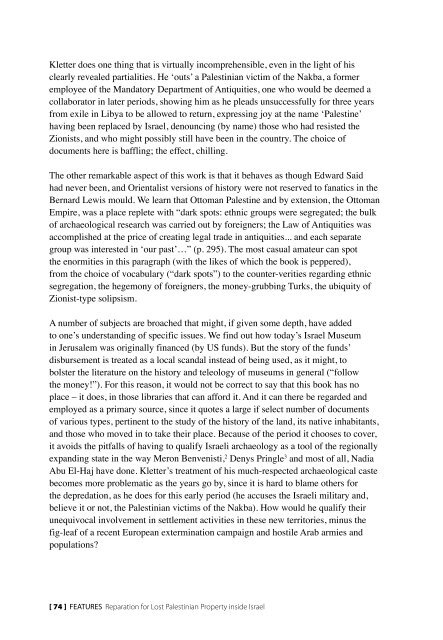
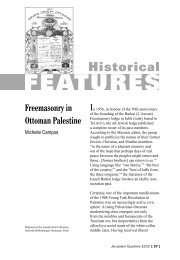
![In Search of Jerusalem Airport [pdf] - Jerusalem Quarterly](https://img.yumpu.com/49007736/1/180x260/in-search-of-jerusalem-airport-pdf-jerusalem-quarterly.jpg?quality=85)
